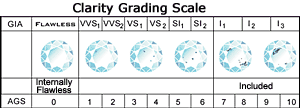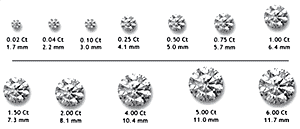|
|
|
To establish a diamond's quality, jewelers examine each of the 4 Cs – cut, clarity,color and carat weight. The combination of the 4 Cs determines the value of a particular diamond.
|
 First, don't confuse diamond "cut" with "shape." Shape refers to the general outward appearance of the diamond, (such as round, emerald, or pear). When a diamond jeweler says "cut," that's a reference to the diamond's reflective qualities, not the shape. First, don't confuse diamond "cut" with "shape." Shape refers to the general outward appearance of the diamond, (such as round, emerald, or pear). When a diamond jeweler says "cut," that's a reference to the diamond's reflective qualities, not the shape.
Diamond cut is perhaps the most important of the four Cs, so it is important to understand how this quality affects the properties and values of a diamond. When we talk about Cut as a value factor, we're also talking about the proportions, symmetry and finish of a diamond. A good cut gives a diamond its brilliance, which is that brightness that seems to come from the very heart of a diamond. The angles and finish of any diamond are what determine its ability to handle light, which leads to brilliance.
|
 When we speak of a diamond's clarity, we are referring to the presence of identifying characteristics on and within the stone. While most of these characteristics are inherent qualities of the rough diamond and have been present since the earliest stages of the crystal's growth below ground, a few are actually a result of the harsh stress that a diamond undergoes during the cutting process itself. When we speak of a diamond's clarity, we are referring to the presence of identifying characteristics on and within the stone. While most of these characteristics are inherent qualities of the rough diamond and have been present since the earliest stages of the crystal's growth below ground, a few are actually a result of the harsh stress that a diamond undergoes during the cutting process itself.
If you think about the incredible amount of pressure it takes to create a diamond, it's no surprise that many diamonds have inclusions on the inside (clouds, feathers, included crystals) or surface blemishes (scratches, polish lines, extra facet). Diamonds with no or few inclusions and blemishes are more highly valued than those with less clarity, not just because they are more pleasing to the eye, but also because they are rarer.
Diamonds are graded for clarity under 10x loupe magnification. Grades range from Flawless, diamonds which are completely free of blemishes and inclusions even under 10x magnification, to Included 3, diamonds which possess large, heavy blemishes and inclusions that are visible to the naked eye.
|
 When jewelers speak of a diamond's color, they are usually referring to the presence or absence of color in white diamonds. Color is a result of the composition of the diamond, and it never changes over time. When jewelers speak of a diamond's color, they are usually referring to the presence or absence of color in white diamonds. Color is a result of the composition of the diamond, and it never changes over time.
Because a colorless diamond, like a clear window, allows more light to pass through it than a colored diamond, colorless diamonds emit more sparkle and fire. The formation process of a diamond ensures that only a few, rare diamonds are truly colorless. Thus the whiter a diamond's color, the greater its value. NOTE: Fancy color diamonds do not follow this rule. These diamonds, which are very rare and very expensive, can be any color from blue to green to bright yellow. They are actually more valuable for their color.
To grade 'whiteness' or colorlessness, most jewelers refer to GIA's professional color scale that begins with the highest rating of D for colorless, and travels down the alphabet to grade stones with traces of very faint or light yellowish or brownish color. The color scale continues all the way to Z.
Diamonds graded D through F are naturally the most valuable and desirable because of their rarity. Such diamonds are a treat for the eyes of anyone. But you can still obtain very attractive diamonds that are graded slightly less than colorless. And diamonds graded G through J show virtually no color that is visible to the untrained eye.
|
 A carat is a unit of measurement, it's the unit used to weigh a diamond. One carat is equal to 200 milligrams, or 0.2 grams. The word "carat" is taken from the carob seeds that people once used in ancient times to balance scales. So uniform in shape and weight are these little seeds that even today's sophisticated instruments cannot detect more than three one-thousandths of a difference between them. A carat is a unit of measurement, it's the unit used to weigh a diamond. One carat is equal to 200 milligrams, or 0.2 grams. The word "carat" is taken from the carob seeds that people once used in ancient times to balance scales. So uniform in shape and weight are these little seeds that even today's sophisticated instruments cannot detect more than three one-thousandths of a difference between them.
NOTE: Don't confuse "carat weight" with "karat," the method of determining the purity of gold.
The process that forms a diamond happens only in very rare circumstances, and typically the natural materials required are found only in small amounts. That means that larger diamonds are uncovered less often than smaller ones. Thus, large diamonds are rare and have a greater value per carat. For that reason, the price of a diamond rises exponentially to its size.
|
|
